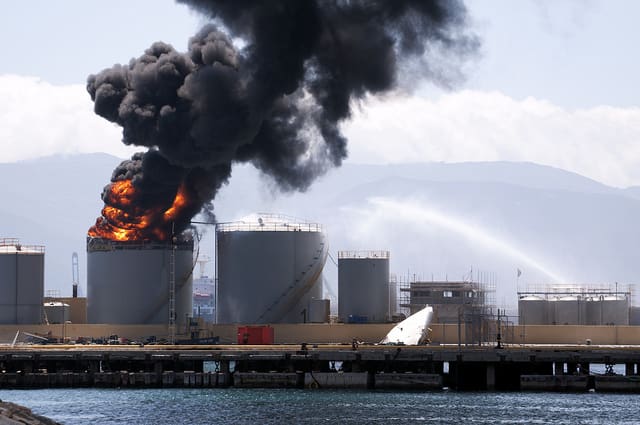Why do petrochemical plants need lightning protection And How does it Differ.
Well, the economics of the petrochemical industry dictates that the processing of petroleum products reside in very large plants. Also, many of which in situ, in parts of the world where thunderstorms frequently occur. Therefore, a number of reasons why lightning is a particular hazard for petrochemical processing facilities:

- Storage and processing of extremely flammable substances
- Large steel plant structures
- Location in exposed areas such as plains and deserts, or off-shore
- Complex processes sensitive to interruption; a fire can cause loss of production costing a million pounds or more per day
The Dangers of a Lightning Strike

A Swedish study of incidents between 1951 and 2003 showed that every year, across the world. Lightning strikes were responsible for fifteen to twenty serious incidents involving fires in petrochemical facilities. Furthermore, it is likely that as the industry has expanded, the figure would nowadays be higher. Importantly, lightning is the single largest attributable cause of tank fires. Such as the fire in 1990 which destroyed a 670,000 barrel storage tank at a Nigerian petroleum facility. Or the Kansas City fire in 2008 which ignited a tank containing 1.2 million gallons of unleaded petrol. Also in 2008, a cracker at Maoming Petrochemical Plant in Shanghai shut down, after two furnaces caught fire, following a short circuit resulting from a lightning strike.
Drawbacks of Traditional Lightning Protection
The lightning rod. As invented by Benjamin Franklin over two centuries ago. Worked very well to protect the buildings and structures in use at the time. By providing a low-impedance path between cloud and ground. However, the large electromagnetic field generated by a lightning strike can cause damage in ways not anticipated by Franklin.
Surge currents and short circuits, such as those which occurred at Maoming. Can result from induced currents in electrical systems. Also, in the presence of highly flammable fluids and vapours, fire risk from short circuits is inevitably high. Furthermore, sparks can occur across small gaps. Which necessarily exist between the roof and the shell in a floating-roof petroleum storage tank. A study of storage tank accidents carried out in Taiwan. Showed that lightning-caused, nearly all fires in the rim seals of floating-roof tanks. So, clearly, a traditional lightning conductor provides insufficient protection from the risks of this kind.
Effective Lightning Protection for Petrochem
Protecting a large petrochemical processing facility from damage caused by lightning. Therefore, requires a systematic, multi-faceted approach and the very best in modern knowledge and technology. Also, every component of the plant needs to be considered separately for the protection to operate as it should.
What Next?
If you are interested in finding out what GreyMatters can do for you in terms of petrochem lightning protection click here for more information or speak with a member of the team on 0117 247 0050.
Featured Image: (image: Jonathan Perera, license: CC BY 2.0)
Interior Image: firehouse.com
Engage with us…
- Earthing Design Services & Lightning Protection Design – If high voltage power systems and lightning are causing you concern why not see how we can help with a quick ‘live chat’ below as a start.
- XGSLab – A complete software tool for the simulation of Power, Earthing, Grounding and Lightning Systems, get in touch to request a free demo.
- Get Certified – Start your journey to become certified in Power Systems Earthing & Design.
